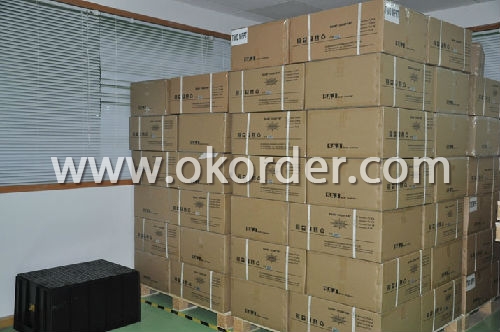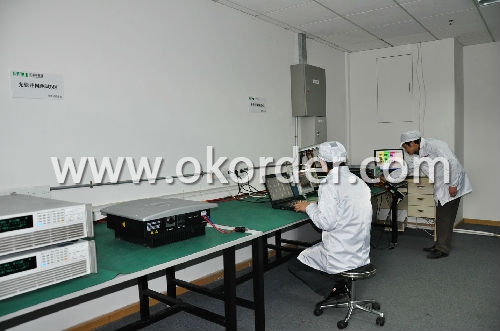Grid Tied Solar Inverter CNBM-2000TL
- Loading Port:
- SHENZHEN
- Payment Terms:
- TT
- Min Order Qty:
- 1 set pc
- Supply Capability:
- 5000 per month pc/month
OKorder Service Pledge
OKorder Financial Service
You Might Also Like
Features of Grid Tied Solar Inverter CNBM-2000TL
CNBM-2000TL is simple national setting of line supply monitoring, Easy country configuration, with Multi-language,display, currently available for most of the countries over the world.With technical creativity and scientific management, the factory established first class R&D and test centers, as well as management and R&D teams comprising of PhDs and masters with overseas qualification.
The full range of CNBM single phase inverters has received VDE, CE, G83/1, G59/2, ENEL2010, VDE4105, C10/C11, AS4777 etc.
Maximum efficiency of 97.8% and wide input voltage range, Internal DCswitch,MTL-String, Sound control,Bluetooth/RF technology /Wi-FiTransformerless,GT topology
Technical data of Grid Tied Solar Inverter CNBM-2000TL
Model | CNBM-2000TL | CNBM-3000TL | |
Input data (DC) |
|
| |
Max. DC power | 2300W | 3200W | |
Max. DC voltage | 500V | 500V | |
Start voltage | 150V | 150V | |
PV voltage range | 100V-500V | 100V-500V | |
Max. input current | 12A | 12A | |
Number of MPP trackers /strings per MPP tracker | 1/2 | 1/2 | |
Output (AC) |
| ||
Rated AC output power | 2000W | 2850W | |
Max. AC power | 2200W | 3000W | |
Max. output current | 11A | 15A | |
Power factor | 1 | 1 | |
THDI | <3% | <3% | |
AC connection | Single phase | Single phase | |
Efficiency |
| ||
Max. efficiency | 97.3% | 97.3% | |
Euro weighted efficiency | 96.50% | 96.50% | |
MPPT efficiency | 99.50% | 99.50% | |
Protection devices |
| ||
Output over voltage protection-varistor | yes | yes | |
Ground fault monitoring | yes | yes | |
Grid monitoring | yes | yes | |
General Data |
| ||
Dimensions (W / H / D) in mm | 360/329/132 | 360/329/132 | |
Weight | 11.7KG | 12.2KG | |
Operating temperature range | –25°C ... +60°C | –25°C ... +60°C | |
Altitude | 2000m(6560ft) without derating | ||
Self-Consumption night | < 0.5 W | < 0.5 W | |
Topology | Transformerless | ||
Cooling concept | Natural | Natural | |
Environmental Protection Rating | IP65 | IP65 | |
Features |
| ||
DC connection | H4/MC4(opt) | H4/MC4(opt) | |
Display | LCD | LCD | |
Interfaces: RS485/RS232/Bluetooth / RF/Zigbee/Wifi | yes/yes/opt/opt/opt | ||
Warranty: 5 years / 10 years | yes /opt | ||
Certificates and approvals | CE、VDE 0126-1-1、DK5940、G83/1-1、G59/2、RD1663、EN50438、 VDE-AR-N4105、CEI-021、IEC-62109、ENEL-Guide | ||
With a R&D team more than 100 engineers,40% of the staff, who has been deeply engaged in the photovoltaic industry for 10 years, CNBM takes the mission to increase the inverter availability and efficiency, putting continuous innovation to make CNBM inverter easier for installation and operation, and more cost-effective for solar plant construction.
Figure 1 the production of Grid Tied Solar Inverter CNBM-2000TL

Figure 2 the test lab of Grid Tied Solar Inverter CNBM-2000TL

- Q:Can a solar inverter be used with a solar-powered air conditioner?
- Yes, a solar inverter can be used with a solar-powered air conditioner. A solar inverter is responsible for converting the direct current (DC) electricity generated by solar panels into alternating current (AC) electricity that can be used to power appliances. In the case of a solar-powered air conditioner, the solar inverter would be essential for converting the DC electricity generated by the solar panels into AC electricity to run the air conditioner.
- Q:Can a solar inverter be used with a solar tracker system?
- Yes, a solar inverter can be used with a solar tracker system. The solar inverter is responsible for converting the direct current (DC) generated by the solar panels into alternating current (AC) that can be used to power electrical devices. The solar tracker system, on the other hand, adjusts the position of the solar panels to maximize sunlight exposure throughout the day. Both systems work together to optimize the efficiency and output of the solar power system.
- Q:How do you calculate the efficiency loss due to temperature for a solar inverter?
- To calculate the efficiency loss due to temperature for a solar inverter, you would typically refer to the manufacturer's specifications and documentation. The efficiency loss can be determined by comparing the inverter's rated efficiency at a specific temperature (usually 25 degrees Celsius) to its efficiency at the desired operating temperature. The manufacturer may provide a temperature coefficient, which represents the percentage decrease in efficiency for every degree increase in temperature. By multiplying the temperature coefficient with the difference between the desired operating temperature and the reference temperature, you can estimate the efficiency loss due to temperature.
- Q:What is the role of a synchronization circuit in a solar inverter?
- The role of a synchronization circuit in a solar inverter is to ensure that the inverter's output waveform is synchronized with the grid's waveform. This is important because the grid operates at a specific frequency and voltage level, and any deviation can lead to power quality issues or damage to electrical equipment. The synchronization circuit adjusts the inverter's output waveform to match the grid's waveform, allowing for efficient and safe energy transfer between the solar system and the electrical grid.
- Q:Can a solar inverter be used without solar panels?
- No, a solar inverter cannot be used without solar panels. Solar panels are the primary source of energy for a solar inverter, which converts the direct current (DC) generated by the panels into alternating current (AC) that can be used to power electrical devices. Without solar panels, there is no source of renewable energy for the inverter to convert, rendering it useless.
- Q:Can a solar inverter be used with a backup generator?
- Yes, a solar inverter can be used with a backup generator. In fact, it is a common setup in off-grid or hybrid systems. The solar inverter works by converting the direct current (DC) produced by the solar panels into alternating current (AC) that can be used to power household appliances. When the solar panels are not generating enough power, the backup generator kicks in to provide the necessary electricity. This combination ensures a reliable and uninterrupted power supply.
- Q:What is the maximum AC output current that a solar inverter can provide?
- The maximum AC output current that a solar inverter can provide depends on the specific model and capacity of the inverter. In general, it is determined by factors such as the maximum power rating and efficiency of the inverter, as well as the size and configuration of the solar photovoltaic (PV) system it is connected to.
- Q:Can a solar inverter be used with different types of grounding configurations?
- Yes, a solar inverter can be used with different types of grounding configurations. However, it is important to ensure that the grounding configuration of the inverter is compatible with the specific electrical system it is being connected to. It is recommended to consult the manufacturer's guidelines and local electrical codes to determine the appropriate grounding configuration for safe and efficient operation.
- Q:How does a solar inverter handle power quality issues in the grid?
- A solar inverter manages power quality issues in the grid by utilizing advanced control algorithms and technologies. It actively monitors the grid's voltage and frequency levels, and adjusts the output of the solar system accordingly to ensure compatibility and stability with the grid. This helps in mitigating power fluctuations, voltage sags or swells, and frequency deviations, thereby maintaining a high-quality power supply from the solar system to the grid.
- Q:What is the role of a display interface in a solar inverter?
- The role of a display interface in a solar inverter is to provide real-time information and control options to the user. It allows the user to monitor and understand the performance of the solar inverter, such as the amount of energy being generated, the status of the system, and any potential issues. The display interface also enables the user to adjust and optimize the settings of the inverter, such as voltage and frequency, to ensure efficient operation. Overall, the display interface enhances the user experience by providing visibility and control over the solar inverter's functions.
1. Manufacturer Overview |
|
|---|---|
| Location | Shenzhen,China |
| Year Established | 2010 |
| Annual Output Value | 50 million USD |
| Main Markets | Australia, Euro, America, China. |
| Company Certifications | CE, VDE-AR-N4105, FCC,ETL,CEC,CEI 0-21,G83,G59,SAA,CGC |
2. Manufacturer Certificates |
|
|---|---|
| a) Certification Name | |
| Range | |
| Reference | |
| Validity Period | |
3. Manufacturer Capability |
|
|---|---|
| a)Trade Capacity | |
| Nearest Port | Shenzhen, Guangzhou, Hongkong |
| Export Percentage | 60% |
| No.of Employees in Trade Department | 260 |
| Language Spoken: | English, Chinese |
| b)Factory Information | |
| Factory Size: | 500-1000 |
| No. of Production Lines | 8 |
| Contract Manufacturing | None |
| Product Price Range | 300-40000 USD |
Send your message to us
Grid Tied Solar Inverter CNBM-2000TL
- Loading Port:
- SHENZHEN
- Payment Terms:
- TT
- Min Order Qty:
- 1 set pc
- Supply Capability:
- 5000 per month pc/month
OKorder Service Pledge
OKorder Financial Service
Similar products
New products
Hot products
Related keywords






























